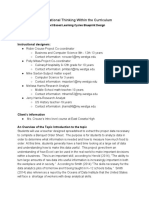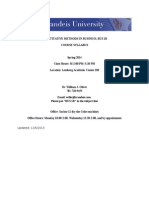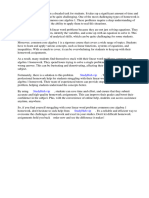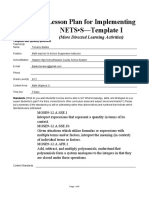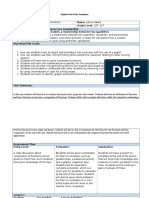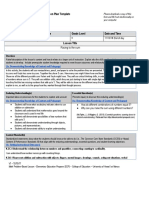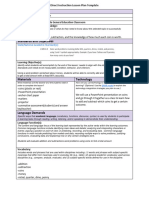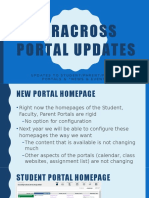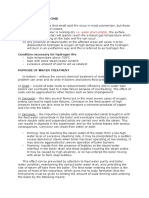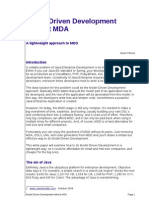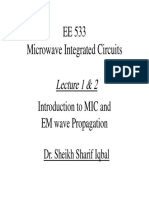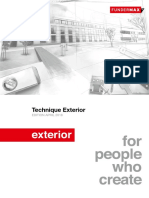Annotated Lesson Plan Form
Annotated Lesson Plan Form
Uploaded by
api-259630476Original Description:
Original Title
Copyright
Available Formats
Share this document
Did you find this document useful?
Is this content inappropriate?
Report this DocumentCopyright:
Available Formats
Annotated Lesson Plan Form
Annotated Lesson Plan Form
Uploaded by
api-259630476Copyright:
Available Formats
Annotated Lesson Plan Form
Name: Kaitlyn Valis
A. Description of Lesson Plan
Academic Subject(s): Algebra II Honors or Precalculus
Grade Level(s): Grades 10-12
Standards Integrated into the Lesson Plan:
Student Content Standards:
CCSS.MATH.CONTENT.HSF.LE.A: Construct and compare linear, quadratic, and exponential
models and solve problems
Indicator.4: For exponential models, express as a logarithm the solution to =
where a, c, and d are numbers and the base b is 2, 10, or e, evaluate the logarithm using
technology (Common Core State Standards, 2014)
CCSS.MATH.CONTENT.HSF.LE.B: Interpret expressions for functions in terms of the situation
they model
Indicator 5: Interpret the parameters in a linear or exponential function in terms of the
context (Common Core State Standards, 2014)
National Educational Technology Standards for Students (2007):
ISTE Standard 2: Communication and Collaboration
Indicator a: Interact, collaborate, and publish with peers, experts, or others employing a
variety of digital environments and media (ISTE, 2007).
ISTE Standard 4: Critical thinking, problem solving, and decision making
Indicator c: Collect and analyze data to identify solutions and/or make informed
decisions (ISTE, 2007).
Learning Objectives for Lesson Plan:
Students will be able to evaluate, solve, and interpret the Compounded Continuously Interest
Function = by hand and by using Excel. Students will also be able to make informed
critical decisions about student loans and communicate their advice using various forms of
presentation media.
Featured Technologies
Internet for research
o http://www.finaid.org/calculators/loanpayments.phtml
o Assorted College/University Websites
Valis Lesson Plan 1
Excel
Presentation Application (PowerPoint, Prezi, Screencast, VoiceThread, Glogster)
The environment that will be necessary for this lesson is a Computer lab or Laptop
Cart that can be brought to the class. Each student or pair will need a computer.
Teacher should investigate with Excel to make sure that they know how to use the
functions needed to evaluate and solve the equations necessary. The teacher should
also have basic knowledge of the presentation software so they can advise and
troubleshoot any problems. It would be a good idea to have a cheat sheet of common
formulas and functions to share with the students and use as a reference.
Other Necessary Materials: It would be helpful for students to have their previous notes on
evaluating and solving exponential functions.
Prerequisite Student Skills:
For this lesson it will be necessary for students to know fundamental principles of
exponential functions and the irrational number e. Student should be able to tell the difference
between exponential growth/decay models and understand simple interest problems. Students
should also understand the inverse relationship between exponential and log functions. In terms
technology students need to have basic knowledge of Excel. This includes how to enter data, use
the function tool, and how to use the drag function to evaluate an entire column of data. If you
feel that some students do not have the necessary prerequisite Excel skills then it might be
helpful to have students explore some tutorials created by MS Office online. This could be a
homework assignment before the lesson to watch some of the tutorials which can be linked to the
class homepage. If the MS Office tutorials do not clearly demonstrate what the students need to
know then the teacher could create their own screencast videos with more focused
demonstrations. No prerequisite knowledge of the presentation software is needed, but it would
be helpful.
Brief Overview of Lesson:
This lesson would be a culminating lesson for the concept because students will need to
know many of the prerequisite information about exponential functions. The lesson will begin
with a brief review of exponential functions and an introduction to the Continuous Compound
Interest equation and the meaning of its different variables. Using the interest equation students
will practice by hand and with Excel how to evaluate for the final amount and how to solve for
the number of years it would take to get a certain amount of money. Students will then spend
time investigating college tuition cost, student loan interest rate, and payoff calculators. Lastly,
students will create a presentation using technology to share their advice and knowledge to their
peers applying to college.
Teacher To Teacher:
Teachers who will be teaching this lesson will need to have knowledge of all of the Excel
functions necessary to complete the lesson. Student either will not know or remember the
functions and shortcuts necessary to investigating Interest amounts using Excel. The teacher will
Valis Lesson Plan 2
need to be actively guiding students through the process, troubleshooting errors, and monitoring
for misuse. Also, it will be helpful to be familiar with a few college websites to guide students to
where to look for tuition and loan information. Teachers should also have basic knowledge of
how the student loan process works. For example, the difference between subsidized and
unsubsidized loans because students will inevitably have questions about this. It is not necessary
that you know or understand how payments are calculated or how student loans are specifically
compounded, but you should have knowledge of how to use and input the right information into
the loan payoff calculator online.
Procedures/Activities:
Day One:
1. Introduction/Warm-Up: Students will do 3-5 exponential function problems where they
will evaluate and identify whether it is a growth or decay function. These problems will
come in the form of a Quick Quiz where students are given the opportunity to recall prior
knowledge and review vocabulary. One problem will also be calculating simple interest
and describing in their own words what Interest is.
2. Teacher Led Instruction: After students are given an opportunity to correct each others
Quick Quiz and to ask any questions that might have come from it, students are
introduced to the idea of compound interest. The teacher will use a guided worksheet
where the students can input the definition of compound interest and the formula for
problems where interest is compounded continuously and incrementally. The guided
worksheet will also discuss the variables and what they mean. Compound Interest
formula: = . The teacher will then do 3 guided problems together with the class.
The first will be a problem where the students are given values for P, r, and t and asked to
find the amount. The second will be a word problem where students are asked to interpret
the information to figure out the values of P, r, and t. The final question will also be a
word problem, but this time the students will be asked to solve for the number of years
(exponent) that it would take for the amount to reach a certain value. During this time the
teacher will be writing the notes on a tablet or SmartBoard for access later if students
needed clarification on the material or were absent. These materials will be uploaded to
the teachers webpage.
3. Introduction of Project: The teacher will direct students to the assignment document on
their teacher page, and then ask students to follow along and ask questions when
necessary. The teacher will describe the expectations for the Excel work, the research
aspect, the Payoff calculator, and the short presentation. All of these activities will be
completed with a partner.
4. Excel: Each person in the pair will create their own Excel document, but they are
encouraged to work collaboratively. Students will be given a guiding worksheet to enter
data into an Excel document. The data being entered will be various Principle values (for
example the amount of the original loan taken out). Students are given 3 different interest
rates to work with (they may use different sheets if that helps them organize) and asked to
represent the amount of money that students would pay back after 1, 3, 5, 10, 15, 20, 25,
and 30 years. Students are encouraged to use function tools to expedite the process. On a
sheet of paper students must do one example by hand to show that the Excel sheet is
calculating correctly. The teacher will be rotating throughout the classroom to answer
questions about the assignment and the features of Excel.
Valis Lesson Plan 3
5. Summarizing Questions: On a separate document to be turned in students will answer
summary questions about their reaction to the values. Is this interest function a growth or
decay model? What surprised you about the data? What did you already know about
interest? If this activity is not completed in class, it will need to be completed for
homework.
Day Two
1. Introduction/Activating Prior Knowledge: The teacher will lead a discussion about
college tuition, student loans, and interest payments. College is a topic on many high
school junior and senior minds so this is an engaging topic that will allow them to share
what they already know. It will also be an opportunity for the teacher to clarify any
misconceptions right at the beginning. Some of the questions might be; have you thought
of where you wanted to go to college? Have you had a conversation with your parents
about the cost of going to school? What is the difference between a loan and a
scholarship? What other cost might be involved in going to college other than tuition?
What are the different types of loans? If students dont know about private loans,
financial aid, subsidized vs. unsubsidized loans now would be a good time to discuss this.
This will definitely be a quick overview and students should be encouraged to speak with
their parents and college counselors for further information.
2. Introduce Activity: Students will still be working in pairs for this project. Students are
asked to first research the college or university of their choice, find the cost of tuition,
and find the cost of room & board. Then they will use an online Payment Calculator to
calculate loan payments. The teacher should emphasize the similarity to the exponential
functions discussed on the previous day but explain that the calculations of making
payments while interest is being added complicate the calculation so that is why they are
using this resource. Using what they know from their investigation students will create a
brief 2-3 minute presentation on advice they would give to students applying for college.
3. Research Cost: Students will use the internet to research the college or university of their
choice. Both members of the pairs should do this, but the pair should choose one to
continue with together. Students should also be encouraged to research other colleges,
community college, and technical school if that is of interest to them. The teacher should
monitor this process to make sure that students are not spending too much time looking at
campus pictures and the student life activities. The college should be one that the students
is interested in to engage them in the process and make it feel more authentic. The
teacher should also remind students that the information and amounts on the schools
website are for one year and most programs are 4 years.
4. Calculate Payments: Students will use the calculator to enter the principle, interest rate,
enrollment status, years in college, and number of years until payoff. Students should
investigate various scenarios, record their findings, and make conclusions about what are
responsible monthly payments and how long it would take to pay the loans off.
5. Presentation: Students may choose the presentation software of their choice, but should
be encouraged to use one they have never used before, such as Prezi, VoiceThread, or
Glogster. The audience of the presentation will be fellow high school students applying
for colleges. What information should they know to make a well informed decision?
What advice would you give them when choosing a college and applying for loans?
Students should include definitions and specific examples from the loan calculator as
well as resources for finding scholarships, financial aid, and further information.
Valis Lesson Plan 4
Student Assessment and Evaluation
Formative Assessment: The Quick Quiz will be a formative assessment (not counted for a
grade) at the beginning of the lesson that serves two purposes. The first is that is gets
students to recall prior knowledge and ask necessary questions. Second, it provides the
teacher with an idea of what might need to be discussed further before moving on. If
students are not able to evaluate or solve, they will not be able to successfully complete
the assignment.
Excel Assignment: Accurate completion of the activity, including the checked work by
hand. If it is completed successfully it will be a good indicator of whether the goals have
been met. In assessing this activity the teacher should be looking for accurate
calculations, organized data, and correct use of the features of Excel. The reflection
questions at the end of the Excel activity provides students an opportunity to reflect on
what they have discovered through the process. This is also a good formative assessment
of whether the students understood the big idea of the lesson and whether they can
interpret the exponential function.
Presentation Self-Evaluation: As a part of the presentation to high school juniors and
seniors, students will be required to complete a self-assessment of their research,
investigation, and synthesis of information in the form of advice. They will also reflect
on the collaborative aspect of the presentation.
Advice Presentations: A rubric will be used to assess the different aspects of the
presentations including professionalism, accuracy of info, and how students
communicated their ideas and opinion to their peers. Clear expectations will be set out
ahead of time and students will have access to the rubric before they begin.
Unit Assessment: The summative assessment for this unit (which includes more than this
lesson) will be a test that assesses the students ability to work with and interpret
exponential functions. Students will also be asked to apply their skills to real-world
problems and describe how their study of student loans has changed or informed their
college search process.
B. Analysis (Rationale)
Rationale for Activities
Students are engaged in learning when they can see the relevance to their current lives as
well as their futures. Making learning relevant and engaging encourages students to take
ownership of their own learning rather than just something they are told or memorize. The lesson
and activities described above were specifically chosen to meet the Common Core Standards and
Valis Lesson Plan 5
ISTE standards established at the beginning and are in line with my educational philosophy of
collaborative and investigative learning. The content is relevant and engaging to the students
because for many they are working through the real world decisions of choosing their next step
after high school.
The activities in this lesson plan were chosen specifically for the mastery of the two
Common Core State Standards referenced at the beginning of the plan. The Excel activity and
the investigation into student loan payments require students to interpret data in the context of
exponential function involving interest. This is clearly in line with
CCSS.MATH.CONTENT.HSF.LE.B.5 which states that students will interpret the parameters
in a linear or exponential function in terms of the context (Common Core State Standards,
2014). Also, having students solve exponential functions using logarithmic functions both by
hand and with Excel gives students exposure and practice expressing solutions of exponentials as
logarithmic functions. This clearly highlights standard CCSS.MATH.CONTENT.HSF.LE.A.4
which states that for exponential models, express as a logarithm the solution to = where
a, c, and d are numbers and the base b is 2, 10, or e, evaluate the logarithm using technology
(Common Core State Standards, 2014).
This lesson and activities clearly fit with my philosophy of teaching because although
there is a short period where material is being demonstrated and modeled by the teacher, the
majority of the two days are spent with students investigating and researching on their own.
Students are asked to make their own conclusions and are asked to effectively communicate their
ideas to others in the form of advice. The Excel activities encourage students to make their own
conclusions and share their own reactions from the data. The research done on student loan
payments requires students to form their own views and share advice that they will hopefully use
Valis Lesson Plan 6
themselves as they are making future decisions. The constructivist approach to education
believes that students come to the class with prior knowledge and experience and the discussion
before the loan calculator activity will give students an opportunity to share what they already
know about interest with the rest of the class. Lastly, by giving students choice in their mode of
presentation delivery and by allowing them freedom in how they organized their Excel data, the
lesson is valuing the unique learning style of students and differentiating instruction.
The scaffolding of the lesson was strategically planned to allow students to recall prior
knowledge and then build on what they already know about the concept. On the first day
students were asked to recall their prior knowledge about exponential functions and those
concepts were built on to support deepening understand of the content and its application to the
real world. The second days opening discussion would allow students to share their own
experiences and opinions about loans and then dive into greater detail; making learning more
meaningful. Each day the lesson moved from teacher directed to student directed giving students
more autonomy over their own education. Since most of the activities are individual or with a
partner this gives the teacher time to walk around and give students individual support if needed.
A different learning environment is established then with a lecture style lesson. Also student
collaboration is a great way for students individual needs to be met not only by the teacher but
by their peers.
Many times in my class students ask why they need to learn a particular concept or how
will this ever help them in real life (especially if they dont become an engineer). These activities
engage students in concept that will affect them in the near and far future. Understanding how
exponential functions work and how interest is calculated is essential to understanding financial
loans at its simplest level. In my experience many of my students have never had these
Valis Lesson Plan 7
conversations with their parents and are completely oblivious to the cost of college and financial
implications for their future. Through these activities students can clearly see the relationship
between what they are studying in math and their own lives.
Explanation of Technology Integration:
Technology plays a key role in the lives of our students and society in general. It has been
used to solve problems and enhance life in many ways. Technology can do the same for teaching
and learning if it is integrated in a purposeful way. In the lesson, technology is used to solve a
few problems. For example, to draw conclusions about exponential functions you need to see
more than a few sets of data and to evaluate these functions by hand, or even with a calculator it
could take valuable instructional time. Excel allows students to easily investigate and test out
what would happen if the rate was changed or if the initial amount was changed. Students are
able to make observations and discover important characteristics of exponential functions. Also,
the activity fostered students creativity by allowing them to choose how they wanted to present
and share their advice with classmates through the open-ended nature of the assignment.
Brookhart (2010) suggests that both choice and open-endedness bred creativity. Technology in
this way transforms learning into something that it was not before, a dynamic creative process.
Allowing students to investigate and discover their own ideas makes learning meaningful
and should be valued for the important skills that are developed. There are clear advantages to
these experiences and in this case they would not have been possible without the use of
technology. If we did not use Excel, students would most likely lose interest in the calculations
or there would have been errors which may lead to misconceptions. As the teacher I could have
used the technology and demonstrated this to the class, but allowing students to work at their
own pace and make discoveries on their own without the teacher is important. Lastly, the use of
Valis Lesson Plan 8
presentation software is an important life skill to have. Students need to develop their ability to
communicate their ideas through different media outlets and applications like Prezi, PowerPoint,
and Glogster. The technology in this lesson is integrated in a way that transforms learning
beyond what is was before.
C. Reflection
Your Learning about Technology and Teaching:
Every day I ask my students to challenge themselves, take risks, and stretch further then
they went before. The best way for me to encourage this is to model it in the way that I teach.
For this lesson I have personally used most of the technology, but integrating it into my
classroom was a new challenge.
My own knowledge and experience with the technology used in this lesson connects with
two aspect of the TPACK model discussed by Roblyer and Doering (2013) in Integrating
Educational Technology into Teaching. In reference to the Excel activity I feel I have the
Pedagogical Content Knowledge necessary to teach the concept and I have my own
Technological Knowledge of Excel, but what is lacking is the Technological Pedagogical
Knowledge. I dont have a lot of experience teaching students how to use Excel. Most of what I
know is from figuring it out on my own, so I am also lacking formal training with it. I think the
activity might also be overestimating students exposure to Excel and their ability to learn it. The
presentational software, specifically Prezi and Glogster, are also fairly new to me in terms of
using them as a resource for students presenting knowledge in class. As a math teacher,
presentations have never been a consistent form of assessment for me, but I am working on
varying assessment and incorporating more of this into my teaching. Again, the area that is a
stretch for me is the Technological Pedagogical Knowledge because I am not sure which
Valis Lesson Plan 9
expectations to set and what the rubric would look like. Lastly, given that I am allowing students
to choose other presentation applications they might choose something that I am not familiar
with, but hopefully that could be an opportunity for me to learn something from the student.
As I was planning this lesson I tried to keep in mind a few of the different models of
technology integration. The most recent that we learned was the Technology Integration Matrix
(TIM) produced by the Florida Center for Instructional Technology (2011-2014) which I believe
is the best model that we have discussed so far. In my opinion this lesson falls between the
adaption and infusion level of integration because as the teacher I am guiding students
independent exploration as well as providing them opportunities to choose the technology they
want to use to demonstrate their knowledge. The best part of this model is the element that
focuses on the environment. I believe that this lesson has a combination of characteristics from
the collaborative environment and the authentic environment because students are working
together in a collaborative nature and they are interacting with real world content that
authenticates the learning experience.
Future Explorations:
Students have various levels of experience with Excel, what are quick ways to introduce students
to the features of Excel without wasting the time of the entire class? See Prerequisite knowledge
Next time I want to explore using web-based Excel applications (GoogleSpreadsheet or Office
365) where students can work in groups on the same document to make adjustments and
observations. This way students would get experience collaborating online, not only in a face-to-
face setting.
Learning from Peer Review:
The peer review process was very helpful in developing a meaningful lesson where
technology was integrated to further and transform learning. For me the peer review was an
affirmation that the lesson that I developed was one that tied in real world skills, encouraged
collaboration with peers, and fostered creativity. Based on the peer review feedback the lesson
was not changed, but details were added to expand and further the lesson, as well as clarify some
Valis Lesson Plan 10
ambiguity in the directions. The only aspect of the review that I choose not to incorporate into
the lesson is something that I plan to incorporate in the future. I intend to further the lesson in the
future to utilize web-based spreadsheet software such as GoogleSpreadsheet, but would like to
do the lesson once with in class collaboration before moving to the cloud based collaboration.
Peer reviewing of my partners lesson was a great way to learn about different types of
technology and how to best implement them into the classroom. From reviewing Matt Yergers
lesson I learned about video recording devices as well as moviemaker applications and software.
I have never incorporated these into my classroom so it was good to see what type of
expectations he set for his students and how he structured the activities. One specific way that he
structured the activity was having students make a plan for their video with storyboards so that
when they went to record they were organized and the recording process was efficient. The
structure of the lesson left little room for off task behavior and created an environment that was
fun and engaging.
The process of the peer review was very structured and organized which lead to effective
collaboration with my peers. I really liked that the group set expectations and agreed upon the
timeline of the process. This alleviated any miscommunication and frustration over the timeline.
Also the clear expectations of what comments and suggestions should be made in the peer
review was great because we were both able to give clear and productive suggestions and
feedback. Setting the expectations for a timely, professional, and courteous review helped to
make the process a positive learning experience.
D. References and Annotated References
Brookhart, S. (2010). Chapter 9: Assessing Creativity and Creative Thinking, Titled: How to
Assess Higher Order Thinking Skills.
This resource was used to discuss the importance of developing creativity skills in
students and ways to better challenge students and assess their ability to think creatively.
Allowing students to use choice and giving more freedom with open ended assignments
fosters creativity in the classroom.
Common Core State Standards. (2014). High school: linear, quadratic, & exponential models.
Retrieved from http://www.corestandards.org/Math/Content/HSF/LE/.
International Society for Technology in Education. (2007). ISTE standards-S. Retrieved from
http://www.iste.org/docs/pdfs/20-14_ISTE_Standards-S_PDF.pdf.
Florida Center for Instructional Technology. (2011-2014). The technology integration matrix.
College of Education, University of South Florida. Retrieved from
http://fcit.usf.edu/matrix/matrix.php.
Valis Lesson Plan 11
Using this resource I analyzed my use of the TIM model of technology integration and
how effectively I integrated technology into the lesson. I highlighted the levels that I felt
the lesson was at as well as the environment in which the lesson occurred.
Roblyer, M.D. & Doering, A.H. (2013). Integrating Educational Technology into Teaching.
Boston, MA: Pearson.
This resource was used to highlight the TPACK model and I analyzed what type of
knowledge was used in creating this particular lesson.
E. Preview of Lesson Plan Implementation
I plan to implement this lesson in the fall of the 2014-2015 school year during the Precalculus
unit on exponential functions. It will also come at a good time because most seniors will be right
in the middle of the college admissions process.
References
National Board for Professional Teaching Standards. (2003). Early adolescence and young
adulthood English language arts portfolio. Arlington, VA: Author.
Valis Lesson Plan 12
You might also like
- Similar PolygonsDocument6 pagesSimilar Polygonsapi-218076936No ratings yet
- Lesson Plan For Implementing NETS - S-Template I: (More Directed Learning Activities)Document5 pagesLesson Plan For Implementing NETS - S-Template I: (More Directed Learning Activities)api-547508373No ratings yet
- A1 U2 LP Systesm of Linear Eq Through Art IntegrationDocument30 pagesA1 U2 LP Systesm of Linear Eq Through Art IntegrationVictoria SchererNo ratings yet
- Top 500 E Retailer Executive List PDFDocument37 pagesTop 500 E Retailer Executive List PDFCloud Nausor50% (2)
- 1999 NISSAN PATHFINDER Service Repair Manual PDFDocument58 pages1999 NISSAN PATHFINDER Service Repair Manual PDFjkfmmsmef0% (1)
- BPT LessonDocument3 pagesBPT Lessonapi-688108430No ratings yet
- BlueprintDocument11 pagesBlueprintapi-424433532No ratings yet
- Enhancing A Lesson With TechnologyDocument5 pagesEnhancing A Lesson With Technologyapi-114453456No ratings yet
- HBMT 4303Document12 pagesHBMT 4303Siti Masni AhmadNo ratings yet
- Whitney Will Is Edu Tech 2220 Lesson PlanDocument5 pagesWhitney Will Is Edu Tech 2220 Lesson PlanWhitney WillisNo ratings yet
- Digital Product Lesson PlanDocument6 pagesDigital Product Lesson Planapi-317619349No ratings yet
- Figueroa Cortez FinishedlpDocument10 pagesFigueroa Cortez Finishedlpapi-279875150No ratings yet
- Quantitative Methods in Business, Bus 1B Course Syllabus: Updated: 12/5/2013Document6 pagesQuantitative Methods in Business, Bus 1B Course Syllabus: Updated: 12/5/2013william1230No ratings yet
- Lesson Plan 521 Graphing Exponential FunctionsDocument5 pagesLesson Plan 521 Graphing Exponential Functionsapi-255937364No ratings yet
- BBPT Weebly DocumentDocument2 pagesBBPT Weebly Documentapi-477529529No ratings yet
- Linear Word Problems Common Core Algebra 1 Homework AnswersDocument5 pagesLinear Word Problems Common Core Algebra 1 Homework Answersh45nhdnd100% (1)
- Bpts TemplateDocument2 pagesBpts Templateapi-444425700No ratings yet
- Itec 7430 Lesson PlanDocument8 pagesItec 7430 Lesson Planapi-276971574No ratings yet
- Lesson Idea 3 BPTDocument2 pagesLesson Idea 3 BPTapi-630714035No ratings yet
- Fdocuments - in - Myp Unit Planner Wikispaces Li Unitplansolveequationwhich Specific MypDocument5 pagesFdocuments - in - Myp Unit Planner Wikispaces Li Unitplansolveequationwhich Specific MypKelly OroszNo ratings yet
- Raines Lessonplan 09-08-14Document7 pagesRaines Lessonplan 09-08-14api-268708704No ratings yet
- Algebrathroughthelensoffunctions1 PDFDocument32 pagesAlgebrathroughthelensoffunctions1 PDFnawafhassan187No ratings yet
- Ccss - Inductive Lesson - Inquiry-1Document4 pagesCcss - Inductive Lesson - Inquiry-1api-242897578No ratings yet
- Adding FractionsDocument4 pagesAdding FractionsWilliam BaileyNo ratings yet
- Lesson Plan For Implementing NETS - S-Template I: (More Directed Learning Activities)Document5 pagesLesson Plan For Implementing NETS - S-Template I: (More Directed Learning Activities)tazbanksNo ratings yet
- TPACK Expressions Unit PlanDocument24 pagesTPACK Expressions Unit Planapi-251069371No ratings yet
- Voulme Lesson 1Document4 pagesVoulme Lesson 1api-330599039No ratings yet
- Hclark Lessonplantemplate-IstefinalDocument6 pagesHclark Lessonplantemplate-Istefinalapi-253519526No ratings yet
- Cep Lesson Plan Algebra 1 8Document7 pagesCep Lesson Plan Algebra 1 8api-733936233No ratings yet
- Excel Lessonplan TechDocument3 pagesExcel Lessonplan Techapi-675339430No ratings yet
- Hqsi Docx 7th Grade Lesson Plan MathDocument3 pagesHqsi Docx 7th Grade Lesson Plan Mathapi-287145795No ratings yet
- Common Core Mathematics Lesson Plan: Lesson Title: Linear & Quadratic Equations - Solving Equations With InequalitiesDocument4 pagesCommon Core Mathematics Lesson Plan: Lesson Title: Linear & Quadratic Equations - Solving Equations With Inequalitiesapi-323931818No ratings yet
- BPT JamesdoaneDocument2 pagesBPT Jamesdoaneapi-475989112No ratings yet
- 03 Basic Productivity Tools Lesson Idea TemplateDocument2 pages03 Basic Productivity Tools Lesson Idea Templateapi-726470647No ratings yet
- Lesson Plan/Title: Subject and Grade Level: Time: ObjectiveDocument4 pagesLesson Plan/Title: Subject and Grade Level: Time: Objectiveapi-522667971No ratings yet
- Lesson PlanDocument23 pagesLesson PlanKendall HallNo ratings yet
- Grade 1 Doc FinalDocument75 pagesGrade 1 Doc Finalapi-32541207No ratings yet
- Lesson Plan For Implementing NETS - S-Template I: (More Directed Learning Activities)Document8 pagesLesson Plan For Implementing NETS - S-Template I: (More Directed Learning Activities)api-323926989No ratings yet
- Stepp Best Fit Line ActivityDocument6 pagesStepp Best Fit Line Activityapi-281839323No ratings yet
- BPT Lesson Plan2Document2 pagesBPT Lesson Plan2api-464176978No ratings yet
- Digital Unit PlanDocument4 pagesDigital Unit Planapi-280875585No ratings yet
- Unit Title: Algebra I Name: Quynhnhu Cao Content Area: Algebra 1P Grade Level:9 Grade Level CA Content Standard(s) /common Core Standard(s)Document4 pagesUnit Title: Algebra I Name: Quynhnhu Cao Content Area: Algebra 1P Grade Level:9 Grade Level CA Content Standard(s) /common Core Standard(s)api-282391859No ratings yet
- Angels Instructional Software IdeasDocument2 pagesAngels Instructional Software Ideasapi-688135233No ratings yet
- Lesson Plan For Implementing NETS - S-Template I: (More Directed Learning Activities)Document5 pagesLesson Plan For Implementing NETS - S-Template I: (More Directed Learning Activities)api-338504614No ratings yet
- Lesson PlanDocument2 pagesLesson Planapi-466380982No ratings yet
- Angels Basic Productivity ToolsDocument2 pagesAngels Basic Productivity Toolsapi-688135233No ratings yet
- Ty Georges Ell Lesson PlanDocument6 pagesTy Georges Ell Lesson Planapi-283337296No ratings yet
- Digital Unit Plan TemplateDocument3 pagesDigital Unit Plan Templateapi-239653134No ratings yet
- Lesson Plan 2 - D, I, J, VariationDocument2 pagesLesson Plan 2 - D, I, J, VariationJe PascualNo ratings yet
- Lesson Plan-Iste - ReynoldsDocument4 pagesLesson Plan-Iste - Reynoldsapi-457531119No ratings yet
- 5E Lesson Plan Template: TeacherDocument3 pages5E Lesson Plan Template: Teacherapi-549594961No ratings yet
- Digital Unit Plan TemplateDocument5 pagesDigital Unit Plan Templateapi-322086224No ratings yet
- Alexa Burns Lesson Plan FinalDocument5 pagesAlexa Burns Lesson Plan Finalapi-320978591No ratings yet
- Kaapana Kaluhi Finalproblembasedlp 1Document15 pagesKaapana Kaluhi Finalproblembasedlp 1api-429821143No ratings yet
- Literacy Lesson PlanDocument7 pagesLiteracy Lesson Planapi-266270177No ratings yet
- Designing An Excel Mini-Unit: AnalysisDocument5 pagesDesigning An Excel Mini-Unit: AnalysisJenSpannNo ratings yet
- Ede4944 ConnectedlessonsDocument14 pagesEde4944 Connectedlessonsapi-293773282No ratings yet
- Math ToolsDocument5 pagesMath Toolscedes414No ratings yet
- Lesson Plan For Implementing NETS - S-Template I: (More Directed Learning Activities)Document9 pagesLesson Plan For Implementing NETS - S-Template I: (More Directed Learning Activities)api-286037854No ratings yet
- Lesson Plan For Implementing NETS - S-Template I: (More Directed Learning Activities)Document4 pagesLesson Plan For Implementing NETS - S-Template I: (More Directed Learning Activities)api-664491465No ratings yet
- Edu Tech Masters Internship ProposalDocument2 pagesEdu Tech Masters Internship Proposalapi-259630476No ratings yet
- Surface Program Faculty FaqDocument2 pagesSurface Program Faculty Faqapi-259630476No ratings yet
- Follow Up Tomon-Hc Tech Prof Dev Form1Document1 pageFollow Up Tomon-Hc Tech Prof Dev Form1api-259630476No ratings yet
- 1-1 Technology PDDocument17 pages1-1 Technology PDapi-259630476No ratings yet
- Combined GoalsDocument18 pagesCombined Goalsapi-259630476No ratings yet
- Veracross Utilization Action PlanDocument2 pagesVeracross Utilization Action Planapi-259630476No ratings yet
- Con - Virtual Learning Debate PrepDocument6 pagesCon - Virtual Learning Debate Prepapi-259630476No ratings yet
- Veracross Portal UpdatesDocument15 pagesVeracross Portal Updatesapi-259630476No ratings yet
- June 15 Tech PD AgendaDocument2 pagesJune 15 Tech PD Agendaapi-259630476No ratings yet
- Valis-Postman PaperDocument9 pagesValis-Postman Paperapi-259630476No ratings yet
- Valis-Toyoma PaperDocument9 pagesValis-Toyoma Paperapi-259630476No ratings yet
- Fundingpaper 1Document15 pagesFundingpaper 1api-259630476No ratings yet
- Valis - Action Research PlanDocument18 pagesValis - Action Research Planapi-259630476No ratings yet
- Valis - Technology Planning PaperDocument22 pagesValis - Technology Planning Paperapi-259630476No ratings yet
- 16-17 Online DiscussionsDocument4 pages16-17 Online Discussionsapi-259630476No ratings yet
- Engaged Learning RubricDocument1 pageEngaged Learning Rubricapi-259630476No ratings yet
- Self PacedDocument2 pagesSelf Pacedapi-259630476No ratings yet
- BCS-053 Solved Assignment 2015-16 PDFDocument18 pagesBCS-053 Solved Assignment 2015-16 PDFJayakrishna IJNo ratings yet
- Development of The Demon Technology Demonstrator UavDocument7 pagesDevelopment of The Demon Technology Demonstrator UavARULKUMARSUBRAMANIANNo ratings yet
- Single Line Drawing S2100-15-220-220 220VAC, 15kVA @40°C: Manufacturing VersionDocument6 pagesSingle Line Drawing S2100-15-220-220 220VAC, 15kVA @40°C: Manufacturing VersionLinh TrầnNo ratings yet
- Armada Tuah 101: 65M Dp2 Anchor Handling & Towing/ Offshore Support VesselDocument2 pagesArmada Tuah 101: 65M Dp2 Anchor Handling & Towing/ Offshore Support VesselClaudio SantellanesNo ratings yet
- HPDeskjet 2540 User ManualDocument102 pagesHPDeskjet 2540 User ManualRICKYNo ratings yet
- HYdROGEN FIREDocument2 pagesHYdROGEN FIREVinothen RajNo ratings yet
- Technovation: Imoh M. Ilevbare, David Probert, Robert PhaalDocument8 pagesTechnovation: Imoh M. Ilevbare, David Probert, Robert PhaalSanjit RameshNo ratings yet
- I20036 - Mn02x4w1-33m149-3tl21a0a10-SDocument3 pagesI20036 - Mn02x4w1-33m149-3tl21a0a10-SYibrail Veliz PluaNo ratings yet
- Model Driven Development Without MdaDocument8 pagesModel Driven Development Without Mdajavierpaniza4768No ratings yet
- Universe 12 Group 4Document3 pagesUniverse 12 Group 4Arvind SarangiNo ratings yet
- Anattalakkhanasutta 1Document139 pagesAnattalakkhanasutta 1Kaung MyatNo ratings yet
- The Effects of Surface Roughness On Adhesion Strength of Coated Ash (Fraxinus Excelsior L.) and Birch (Betula L.) WoodDocument5 pagesThe Effects of Surface Roughness On Adhesion Strength of Coated Ash (Fraxinus Excelsior L.) and Birch (Betula L.) WoodCharis NurhidayatNo ratings yet
- Section Two: Outer ShellDocument65 pagesSection Two: Outer ShellJulian Camilo Moreno CárdenasNo ratings yet
- CHAPTER 7: The Balanced Scorecard: A Tool To Implement Strategy The Balanced Scorecard Features of A Good Balanced ScorecardDocument2 pagesCHAPTER 7: The Balanced Scorecard: A Tool To Implement Strategy The Balanced Scorecard Features of A Good Balanced ScorecardPhia TeoNo ratings yet
- EE 533 EE 533 Microwave Integrated Circuits Microwave Integrated CircuitsDocument11 pagesEE 533 EE 533 Microwave Integrated Circuits Microwave Integrated CircuitsDiDo Mohammed AbdullaNo ratings yet
- Transformer Tech Procedures DPC 34-1032Document73 pagesTransformer Tech Procedures DPC 34-1032M Kumar Marimuthu100% (1)
- Omega V Op Ins 1384.8v3-10Document88 pagesOmega V Op Ins 1384.8v3-10laythmasNo ratings yet
- Industrial Hydraulic SystemsDocument58 pagesIndustrial Hydraulic SystemsMohammed Al-Odat100% (1)
- Guide Form Specification RC-Snubber For Transformer ProtectionDocument4 pagesGuide Form Specification RC-Snubber For Transformer ProtectionMarcos C I SNo ratings yet
- Experiment 4 - Frequency Modulation Using ScilabDocument6 pagesExperiment 4 - Frequency Modulation Using ScilabCleiton Marques0% (1)
- Dodi Juliadi - Profile 070316Document16 pagesDodi Juliadi - Profile 070316Dodi JuliadiNo ratings yet
- SIMODRIVE - Und POWER DRIVE-Umrichtersysteme - en PDFDocument28 pagesSIMODRIVE - Und POWER DRIVE-Umrichtersysteme - en PDFAlexandre Godoi100% (1)
- How To Secure Your WebsiteDocument5 pagesHow To Secure Your WebsiteRotimi Akinyele100% (1)
- Delayed Coker Revamp For A Capacity IncreaseDocument3 pagesDelayed Coker Revamp For A Capacity IncreaseYahya AljarokNo ratings yet
- Astm A 0234 00Document8 pagesAstm A 0234 00Erick Cruz MontañezNo ratings yet
- Placare HPL Prin Lipire Pag 38 PDFDocument108 pagesPlacare HPL Prin Lipire Pag 38 PDFMaria ArionNo ratings yet
- Investigation Factors Resposible For Sucess of Online Brands, Olx PakistanDocument18 pagesInvestigation Factors Resposible For Sucess of Online Brands, Olx Pakistansaad AhmedNo ratings yet
- Atlans CDocument6 pagesAtlans CLeonte DanielNo ratings yet






